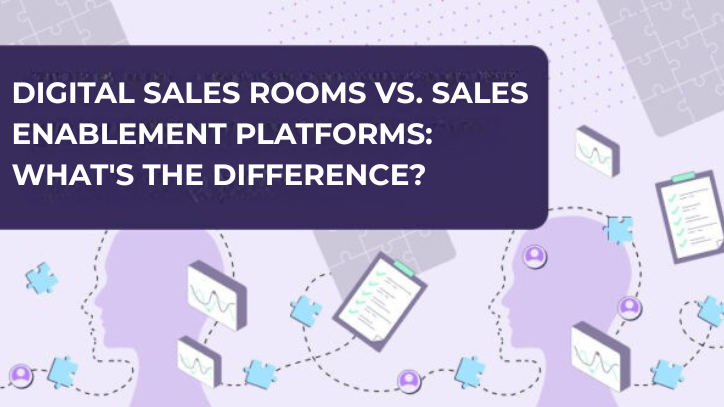In B2B sales, tech stacks are getting crowded—and confused. Two tools that often get lumped together (but shouldn’t) are Digital Sales Rooms (DSRs) and Sales Enablement Platforms (SEPs). Both aim to improve the sales process. But they solve very different problems and serve very different moments in your go-to-market motion.
Let’s clear things up.
A Digital Sales Room (DSR) is a secure, personalized space where sellers and buyers collaborate throughout the deal cycle. Think of it as a special microsite made for each opportunity. It holds all the important content and conversations in one place. No more email scavenger hunts, stale PDFs, or disjointed handoffs. Just one link that keeps the entire buying team aligned and engaged.
Core Capabilities (and what they actually mean):
Deal Centralization
All sales materials are in one central location. This includes interactive demos, case studies, ROI calculators, pricing documents, and legal agreements. This location is customized for each account.
What this means:
Buyers don’t have to search through their inboxes or ask, “Can you send the deck again?” Everything they need to decide is in one organized, branded space. You’re reducing friction and making it easy for them to buy.
Real-Time Engagement Signals
DSRs give sellers visibility into who’s engaging with what content, for how long, and when.
What this means:
You’re not guessing whether the CFO read the proposal—you know. This insight helps reps time their follow-ups well. It also helps them focus on high-intent accounts. They can call for help when momentum slows down.
Shared Workspace
Buyers can leave comments, tag stakeholders, and collaborate within the room—just like they do in Google Docs.
What this means:
You’re empowering your champion to do internal selling on your behalf. And you’re keeping the conversation moving asynchronously, which is critical when deals involve multiple stakeholders across time zones.
Personalization at Scale
Each Digital Sales Room can reflect the buyer’s brand, industry, use case, and business priorities.
What this means:
Your pitch feels more like a tailored experience and less like a one-size-fits-all sales deck. It shows you’ve done your homework—and gives buyers the clarity they need to move forward confidently.
Deal Progress Visibility
DSRs help you track buyer activity and detect deal risk early—like drop-off points or disengaged stakeholders.
What this means:
Instead of getting blindsided at the end of the quarter, you can flag when deals are going cold and intervene before they stall. It’s like having x-ray vision into your pipeline.
What’s a Sales Enablement Platform?
Sales Enablement Platforms focus on the internal side of selling. They are designed to help revenue teams work better behind the scenes. They do not focus on improving the buyer’s experience. Instead, they ensure that sellers have the right tools, content, and training to do their jobs well.
That means:
- Organizing messy content libraries into a central, searchable hub—so reps don’t waste time hunting down the latest deck or case study.
- Onboarding new hires faster with structured playbooks, guided learning paths, and LMS-style modules tailored to different segments or roles.
- Driving consistency across the org by standardizing messaging, talk tracks, and objection handling—so every rep tells the same story, regardless of who they’re selling to.
- Improving coaching and accountability with performance analytics that show what top performers are using, saying, and sending—so leaders can replicate what works and course-correct what doesn’t.
In short, SEPs are designed to reduce internal chaos, level up rep performance, and keep everyone aligned on what “good” looks like. But they stop short of delivering the buyer-facing experience that actually wins the deal. That’s where tools like Digital Sales Rooms step in.
Key Differences, Zero Overlap
| Category | Digital Sales Room | Sales Enablement Platform |
| Primary Focus | Buyer experience and deal progression | Internal sales performance and consistency |
| Audience | Sellers + Buyers | Sellers + Enablement |
| Implementation | Deployed deal-by-deal | Org-wide |
| Content Use | Curated, deal-specific delivery | Internal distribution and training |
| Analytics | Engagement and deal-level signals | Usage and team productivity metrics |
When to Use What
Use a Digital Sales Room When:
You’re in a multi-stakeholder deal and want to align the buying team fast.
B2B deals aren’t won in the first meeting—they’re won in the 10 conversations your champion has after it. A Digital Sales Room provides a central space to share all the information needed for decision-making. No more buried emails, scattered PDFs, or Slack threads with zero context.
Instead of forcing your champion to translate your pitch, you give them a turnkey asset that does the heavy lifting—on demand, at their pace, in their language.- You need to track engagement signals to guide follow-up and forecast accuracy.
Most follow-up emails are sent into the void because sellers don’t know what’s resonating. With a Digital Sales Room, you get visibility into who viewed what, when, and how long they engaged.
Did they open the proposal? Did the VP of Finance watch the ROI explainer? Did the product tour get forwarded to IT? That’s not just interesting—it’s actionable. It helps you prioritize deals, time your outreach, and coach reps with data instead of gut feel. - You’re tired of losing momentum in the handoff from call to email to procurement.
Post-demo drop-off is real. You had a great call. Then… silence. Why? After the meeting, your buyer has to recap everything to their team. They do this with a half-remembered story and a messy inbox.
Digital Sales Rooms solve this by keeping the story alive after the Zoom call ends. They offer a consistent, branded space. Here, prospects can revisit your value proposition, explore interactive demos, and find answers without waiting for you. That continuity shortens sales cycles, reduces ghosting, and builds trust.
Use a Sales Enablement Platform When:
- Your reps can’t find the right deck—or worse, use outdated ones.
If your sales floor sounds like “Where’s the latest pricing slide?” or “Is this the new messaging?”—you’ve got a content chaos problem. Sales Enablement Platforms fix that by serving as a single source of truth.Reps no longer have to guess which version is current. They won’t slow down deals with off-brand materials. Instead, they can quickly access the right content. This content is version-controlled, role-specific, and pre-approved. It’s content governance meets sales velocity.
- You need to train at scale or drive consistency across a growing sales org.
Every new rep means ramp time. Every new product means retraining. Every new market means adjusting your message. Doing that manually—or hoping it trickles down through tribal knowledge—won’t cut it.Sales Enablement Platforms help you define what “great” looks like and share it widely. They provide onboarding paths, battle cards, objection handling, and interactive learning modules. All of these are customized for each rep’s role, region, or segment. It’s how you build muscle memory across a distributed team without breaking the enablement team.
- You want to measure the impact of enablement content on sales performance.
It’s one thing to create a beautiful pitch deck. It’s another to know whether it’s actually helping reps close deals. SEPs provide insight into which assets are being used, who’s using them, and what’s driving outcomes.
You’ll learn which talk tracks land, which content gets ignored, and which reps are following the playbook—and which aren’t. That means smarter coaching, tighter alignment with marketing, and better decisions about where to invest your enablement budget.
Why the Best Teams Use Both
These tools aren’t competing. They’re complementary. SEPs optimize the seller’s readiness. DSRs optimize the buyer’s journey. Together, they give your GTM team a full-field view and the tools to execute at every touchpoint.
Here’s how the workflow looks when done right:
- Enablement Platform delivers the right playbook and content.
- Rep uses that content inside a personalized Digital Sales Room.
- Engagement insights flow back to the CRM and SEP for feedback loops and coaching.
Making the Right Call
If your sales team is drowning in content chaos, start with a Sales Enablement Platform.
If your buyers are ghosting, deals are stalling, or champions can’t “sell it internally,” prioritize a Digital Sales Room.
For most enterprise sales teams, the right move isn’t either/or—it’s sequencing the rollout based on your most urgent bottleneck.
It’s About Buyer Experience
B2B buyers don’t want another Zoom call. They want clarity, speed, and control. DSRs meet them where they are—offering a consumer-grade experience in an enterprise motion. SEPs make sure your reps show up ready.
If your goal is shorter cycles, stronger champions, and a cleaner path to revenue, you need both. Just don’t expect them to solve the same problem.
Ready to offer buyers a better experience?
Start creating interactive, shareable, data-driven demos inside Digital Sales Rooms today.
👉 Get started with Walnut





